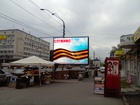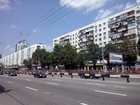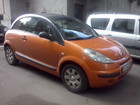L-series 2013: what LG state employees are capable of
Hello! I want to introduce you to the budget LG L-series smartphones. Today there are three candidates for your attention on the menu: the second generation L3, L4 and L5. How does it feel to use a low-end smartphone when you use a flagship Google phone in everyday life? Is there life on mars with such hardware? What to choose if you want a smartphone, but there isn’t much money? You can find the answer to all these questions under the cut.
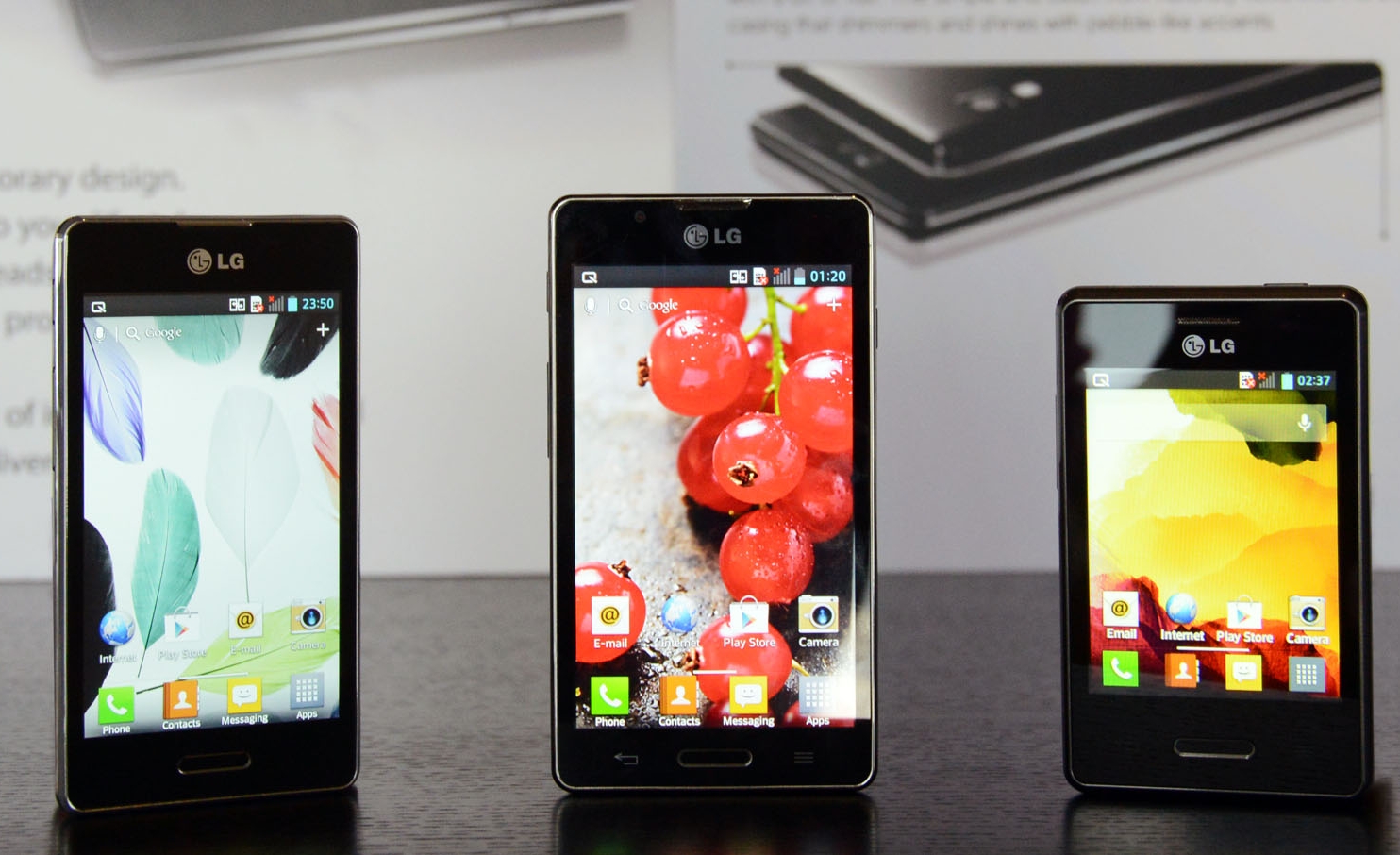
All three smartphones are state employees, and their characteristics fit perfectly into the general hierarchy of the L-series from LG. See the tablet:
')
A clear gradation “from junior to senior” is easily traced, but, more interestingly, a peculiar feature of the entire line is noticeable - a decent amount of batteries, internal memory (MircoSDHC, of course, supported), and a good IPS screen even in the most budget solutions. The second pleasant moment in the entire line is the current version of Android - 4.1.2, which is quite topical today, over which the third-party Optimus UI interface (that is exactly the same as in the flagship Optimus G, corrected for screen size, yes The “windowed mode” for selected applications was also deprived of it - not the hardware capabilities to mess with such features). Let's go directly to the device?
I had a dvuhsimochnaya version in my hands. Information about odnosimochnik in terms of appearance and work with the button "home" can be extrapolated from both L7 II and Internet sources. It looks like this:

Appearance dvuhsimochnika - direct reduced copy of the same L7 II Dual: the same colors, materials and design solutions. It's nice that LG have developed their own style, have established the production of a whole line of devices with this style, have divided one- and two-simulated devices in appearance, leaving them almost identical inside.
I see no point in describing it, see a better photo:
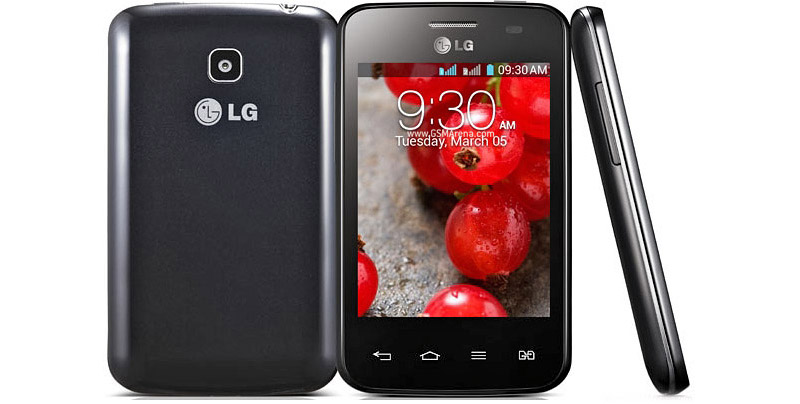
The device is perfectly in the hand, does not slip, the screen, even if small, responds well to touches, all buttons, connectors and technological holes are in predictable places.
The back panel is removed only when a sufficient amount of effort is applied, it does not fall off itself, and the “latches”, if you can call them that, do not look unreliable. However, given the dvuhsimochnuyu nature of the device, it is unlikely you will often get under the cover: put a SIM card "for calls" and "for the Internet", and into battle.
It looks, respectively, as a reduced single-symbol L7 generation of 2013: the same materials, forms, texture of the back panel, the same “home” button with the function of LED notification of various phone statuses. Multicolor backlighting reflects missed calls and SMS, calendar events, alarm and other typical alarms. Unfortunately, the dvuhsimochnik of this magnificence is deprived, however its price (in theory) should not differ from the single-value option, so either ryushechki, or two sims - choose the user.
The performance of budget smartphones is difficult to adequately assess. On the one hand, the flagship devices simply scoff at ratings in benchmarks, on the other hand, there are Chinese phones with a price of up to 150 evergreens, a lottery on a hotspot and a floating quality. I don’t have anything against great models like JiaYu G2, but if you don’t trust the Chinese, you’d like it and generally you want to touch it first and then buy it, then this option is not for you. For myself, I have developed a rather interesting variant of measuring the “power” of the state employee: the result of the Antutu benchmark should be divided by the price in dollars at the current moment (at the time at which you plan to buy a phone). Thus, we get an excellent indicator "parrot for a dollar", showing how much the hardware stuffing corresponds to the price, and where the point comes after which the cost ceases to give a tangible performance increase.
For Oplimus L3 II, the rating will be as follows: the price is average, according to the market - 5,300 rubles, in dollars - about $ 166, the rating in Antutu Benchmark - about 4,300 points. We divide the second into the first, we get - 25.9 parrots for 1 dead US president.
Now, in fact, about the sensations of working with a smartphone, as a criterion of "sufficiency" of the performance of the filling.
It’s hard to call a phone a rocket or a supersonic fighter, and Ferrari is far away from him, but he is quite drawn to the title of Renault Logan. Judge for yourself: the processor is modest, technologically simple, but it works at a normal frequency. The screen is not very big, but good. The camera seems to be there, they did not regret the memory, the case did a pretty one. Yes, budget, but everything works, in the browser there are no problems with browsing pages, simple toys such as birds, four cutters or fashionable now subway run (or whatever it is) - work, music plays, he can call. The smartphone performs all these actions without any difficulties: the animations and transitions are fairly smooth, the scrolling on the pages of the habr does not tupit, the camera works at normal speed, and switching between a toy and a browser with 5 open tabs takes only a couple of seconds. LG engineers found a good balance of performance, and as a result we have a great low-end smartphone.
The Optimus UI interface does not slow down - thanks to the low resolution of the screen. If you compare the L3 with the old man Optimus One, then the latter seems just a dinosaur - an old Android 2.3, a battery that is sagging enough and the ARM v6’s general slowness of the processor at not the highest frequency make themselves felt. But the display resolution is slightly higher, and it is assembled solidly. Not for nothing in his time in terms of price / performance was nothing better. In any case, after the L3 II, even the old, albeit a good state employee, seems slow and "dull", and if you take into account the fact that the newcomer works on the current version of Android and supports the modern UI, it immediately becomes clear how budget smartphones stepped towards the buyer.
The display is small, only 3.2 inches diagonal. Resolution - appropriate - hVGA. Another thing is important - in a state employee there is an honest AH-IPS matrix (six-bit, naturally), with excellent viewing angles, brightness, contrast and good color reproduction. Not that the latter would be very important in a state employee, but the screen, normal in quality and viewing angles, is a fat plus, because a touchscreen smartphone, forgive me, consists of a good half of the screen and look at a vague, fading and non-contrast screen - pleasure is something else . And here - everything is OK, and the letters are read, and the pictures look normal, and even, if you wish, you can see something on YouTube.
The camera is there, it makes frames with a resolution of 3 megapixels, is set to hyperfocal RF and does not have a flash. To take a photo of a person on a bell, announcement, sports car, standing on the street - you can, on this and that.
The video camera also shoots, but I didn’t even test this functionality - obviously you shouldn’t expect miracles here, and the function is needed, rather, because it has already become the norm and there are no difficulties to implement it.
A sore question for Android devices, according to the bitten by Apple’s market users. With autonomy, everything is ok: the series put in a loop was played for about six hours with 50% screen brightness, after which the L3 II gave up and said goodbye to the user. In the “budget smartphone” mode (both SIM cards are stuck, in one of them there is always an available edge-connection, in the other - calls and SMS), using social networks, SMS and calls, the phone is more or less confidently holding 2 - 2.5 days. If you play with birds or constantly read books (from such a screen is dubious pleasure), it will die within a day. Given its cost, the device keeps up with dignity, and if you take into account the fact that LG Chem is one of the world leaders in the development of custom batteries, you can safely be sure that after half a year and a year the result will remain the same. The battery life of LG has always been great enough.
It was not without drawbacks, but rather, they are direct continuations of desires to save on one thing in order to provide bonuses in something else.
The entire L-series does not have a light sensor (although the L5 has a sensor that turns off the screen when the smartphone is brought to the ear), and the display brightness must be adjusted manually. Fortunately, the brightness setting made in the notification panel, and it can be used blindly.
The second problem applies only to Dualsim versions - absolutely no backlight on-screen buttons. We'll have to get used to their location and poke blindly in the dark. At odnosimochnika this problem is at least partially solved by highlighting the home button.
The phone I was able to communicate with the least of all - he only stayed with me for a couple of hours, but during this time I managed to make some impression. If we describe it very briefly, this is a compromise between the L5 and L3 of the second generation, which is perfectly reflected in its “intermediate” name. The hardware capabilities are the same as that of the older brother, the screen is slightly simpler, which is why the system works even faster (reduced load on the graphics core), the camera from L3 (but already with flash), the battery from L5, in general - a decent average, especially considering the average price on Yandex. The market is 4,900 - 5,000 rubles. There is also a single-character version, with a distinctive design and a multicolor central button.
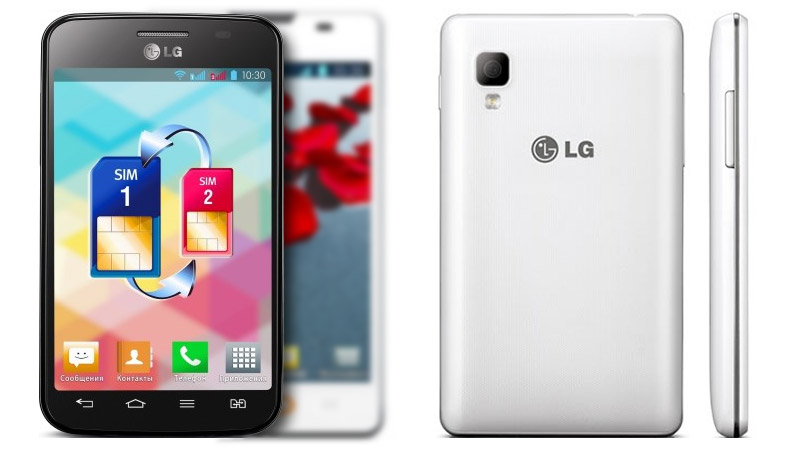
Last year’s L5 is the closest to the L4 II, except that the Quartet works much faster.
Again I had a dvuhsimochnik in my hands, this time - not even a “release one”, but with an engineering ROM. The design corresponds to the entire L-ruler, except that this time the camera is located not in the center, but pressed to the right edge of the smartphone.
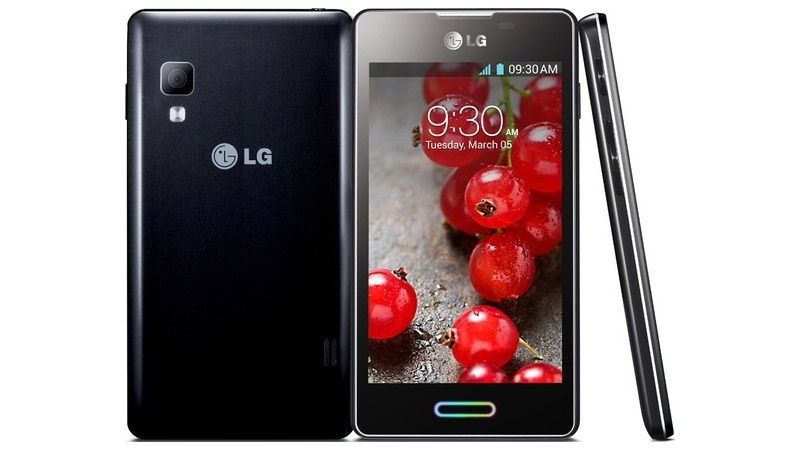
The last generation L5 had a more “angular” and “short” design, a good balance of performance and price, but it differed with a disgusting screen and not the most enduring battery.
LG conducted a thorough work on the bugs, correcting most of the shortcomings and that's what happened with them.
As a central processor, the Chinese chip MTK 6575, which has one core at 1 GHz, but built on the Cortrex A9 architecture, with all its bonuses in the form of extraordinary execution of instructions or full support of multimedia instructions NEON. This directly affected the performance as well as possible - the phone is not tupit and works much faster than last year’s version of the L5 (and even more so the L7). In the Antutu device, the device scored 4589 points, the average price was 7,100 rubles, or ~ 215 dollars. The result - 21 parrots / dollar. Not the highest ratio, but I think it will be more interesting in stock ROMs, and you should take into account a good screen in the “penny”.
Comparison with Logan doesn't roll anymore, here we have, rather, something more decent. The closest analogue in the auto world, perhaps, is the Nissan Primera - not very big, but already an “adult” car from a decent manufacturer.
The system is responsive and pleasant to use, works fine with a resolution of 480x800, does not “clog up” after a few days of use, the memory governor copes with its work, constantly “clean” the device is not required. For a state employee - the result is more than worthy.
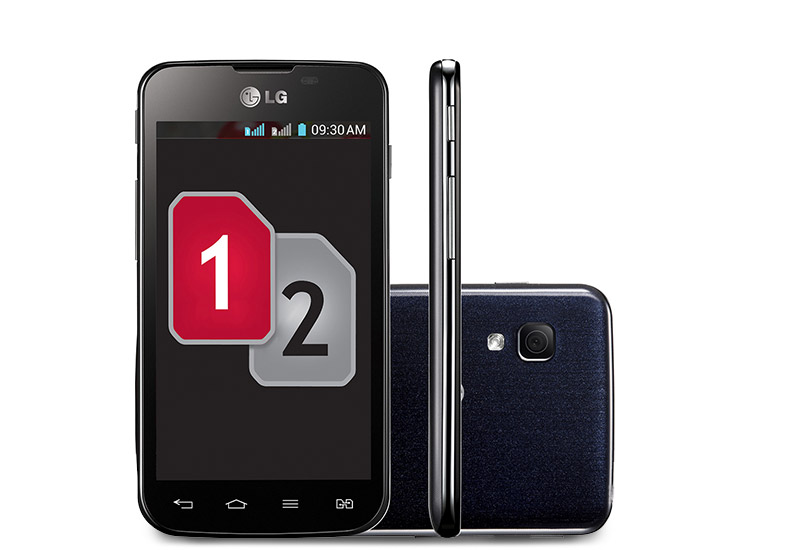
If to compare with the past L5, then progress is more likely external (improvements on all fronts). If with the previous generation L7 - then progress is noticeable in terms of software and performance - applications no longer blunt, Optimus UI system is not a burden, and the use of a normal processor allows you to not experience difficulties in everyday use.
The pride of state employees - AH-IPS matrix, 480x800 pixels. Excellent viewing angles (we say hello to L5 last year, with its nightmarish “whitening” of the screen when it deviates from the normal), brightness and contrast are also at a decent level. Solid Five.
The camera is like a camera, what else can you expect from a state employee? 5 megapixels, autofocus, flash. Suitable for everyday telephone use, not more. Here are the shots taken from the release versions of the smartphone from the Runet open spaces:
Video camera also shoots formats: 640x480, 320x240, 176x144. Nothing extraordinary can be expected, but the presence of a feature is not its absence. :)
Autonomy repeats it in L3 II: the series put into the loop was reproduced for about five to six hours with 50% screen brightness, with more or less active use of the smartphone, it lasts a day and a half.
The disadvantages are the same.
The entire L-series does not have a light sensor (although the L5 has a sensor that turns off the screen when the smartphone is brought to the ear), and the display brightness must be adjusted manually.
The button illumination problem for Dualsim phones has not gone away. Get used to, or take odnosymochnik.
Three excellent state employees, pleasing with pleasant screens and sufficient performance, divided into quite an acceptable price tag. Someone will prefer the Chinese, someone will take second-hand, well, and these devices will find their customers, both among adults and as a gift to schoolchildren, desperately begging for a touch phone from their parents. A simple, reliable, with a long-lasting battery, a good screen and a modern OS - these are the characteristics that you want to get by buying a “simple” smartphone. The LG L-series answers practically all these requests, remaining decent both externally, and internally, and financially. The next step is the LTE-smartphone Optimus F5 - not expensive, but very interesting.

Hardware
All three smartphones are state employees, and their characteristics fit perfectly into the general hierarchy of the L-series from LG. See the tablet:
| L3 II | L4 II | L5 II | L7 II | |
| CPU | MSM 7225A @ 1 GHz (Cortex A-5) | MTK 6575 @ 1 GHz (Cortex A-9) | MTK 6575 @ 1 GHz (Cortex A-9) | MSM8225 @ 1GHz (Dualcore Coretx A-5) |
| RAM | 512 MB | 512 MB | 512 MB | 768 MB |
| Internal memory | 4 GB | 4 GB | 4 GB | 4 GB |
| Screen | TFT-IPS, 3.2 ", 240x320 | TFT-IPS, 3.8 ", 320x480 | TFT-IPS, 4 ", 480x800 | TFT-IPS, 4.3 ", 480x800 |
| Camera | 3 MPx, no autofocus and flash | 3 MPx, no autofocus, flash | 5 mpx, autofocus, flash | 8 mpx, autofocus, flash |
| Battery Capacity | 1540 mAh | 1700 mAh | 1700 mAh | 2640 mAh |
')
A clear gradation “from junior to senior” is easily traced, but, more interestingly, a peculiar feature of the entire line is noticeable - a decent amount of batteries, internal memory (MircoSDHC, of course, supported), and a good IPS screen even in the most budget solutions. The second pleasant moment in the entire line is the current version of Android - 4.1.2, which is quite topical today, over which the third-party Optimus UI interface (that is exactly the same as in the flagship Optimus G, corrected for screen size, yes The “windowed mode” for selected applications was also deprived of it - not the hardware capabilities to mess with such features). Let's go directly to the device?
LG Optimus L3 II dual
I had a dvuhsimochnaya version in my hands. Information about odnosimochnik in terms of appearance and work with the button "home" can be extrapolated from both L7 II and Internet sources. It looks like this:

Appearance dvuhsimochnika - direct reduced copy of the same L7 II Dual: the same colors, materials and design solutions. It's nice that LG have developed their own style, have established the production of a whole line of devices with this style, have divided one- and two-simulated devices in appearance, leaving them almost identical inside.
I see no point in describing it, see a better photo:

The device is perfectly in the hand, does not slip, the screen, even if small, responds well to touches, all buttons, connectors and technological holes are in predictable places.
The back panel is removed only when a sufficient amount of effort is applied, it does not fall off itself, and the “latches”, if you can call them that, do not look unreliable. However, given the dvuhsimochnuyu nature of the device, it is unlikely you will often get under the cover: put a SIM card "for calls" and "for the Internet", and into battle.
Odnosimochny L3 II - features
It looks, respectively, as a reduced single-symbol L7 generation of 2013: the same materials, forms, texture of the back panel, the same “home” button with the function of LED notification of various phone statuses. Multicolor backlighting reflects missed calls and SMS, calendar events, alarm and other typical alarms. Unfortunately, the dvuhsimochnik of this magnificence is deprived, however its price (in theory) should not differ from the single-value option, so either ryushechki, or two sims - choose the user.
Performance
The performance of budget smartphones is difficult to adequately assess. On the one hand, the flagship devices simply scoff at ratings in benchmarks, on the other hand, there are Chinese phones with a price of up to 150 evergreens, a lottery on a hotspot and a floating quality. I don’t have anything against great models like JiaYu G2, but if you don’t trust the Chinese, you’d like it and generally you want to touch it first and then buy it, then this option is not for you. For myself, I have developed a rather interesting variant of measuring the “power” of the state employee: the result of the Antutu benchmark should be divided by the price in dollars at the current moment (at the time at which you plan to buy a phone). Thus, we get an excellent indicator "parrot for a dollar", showing how much the hardware stuffing corresponds to the price, and where the point comes after which the cost ceases to give a tangible performance increase.
For Oplimus L3 II, the rating will be as follows: the price is average, according to the market - 5,300 rubles, in dollars - about $ 166, the rating in Antutu Benchmark - about 4,300 points. We divide the second into the first, we get - 25.9 parrots for 1 dead US president.
Now, in fact, about the sensations of working with a smartphone, as a criterion of "sufficiency" of the performance of the filling.
It’s hard to call a phone a rocket or a supersonic fighter, and Ferrari is far away from him, but he is quite drawn to the title of Renault Logan. Judge for yourself: the processor is modest, technologically simple, but it works at a normal frequency. The screen is not very big, but good. The camera seems to be there, they did not regret the memory, the case did a pretty one. Yes, budget, but everything works, in the browser there are no problems with browsing pages, simple toys such as birds, four cutters or fashionable now subway run (or whatever it is) - work, music plays, he can call. The smartphone performs all these actions without any difficulties: the animations and transitions are fairly smooth, the scrolling on the pages of the habr does not tupit, the camera works at normal speed, and switching between a toy and a browser with 5 open tabs takes only a couple of seconds. LG engineers found a good balance of performance, and as a result we have a great low-end smartphone.
The Optimus UI interface does not slow down - thanks to the low resolution of the screen. If you compare the L3 with the old man Optimus One, then the latter seems just a dinosaur - an old Android 2.3, a battery that is sagging enough and the ARM v6’s general slowness of the processor at not the highest frequency make themselves felt. But the display resolution is slightly higher, and it is assembled solidly. Not for nothing in his time in terms of price / performance was nothing better. In any case, after the L3 II, even the old, albeit a good state employee, seems slow and "dull", and if you take into account the fact that the newcomer works on the current version of Android and supports the modern UI, it immediately becomes clear how budget smartphones stepped towards the buyer.
Screen
The display is small, only 3.2 inches diagonal. Resolution - appropriate - hVGA. Another thing is important - in a state employee there is an honest AH-IPS matrix (six-bit, naturally), with excellent viewing angles, brightness, contrast and good color reproduction. Not that the latter would be very important in a state employee, but the screen, normal in quality and viewing angles, is a fat plus, because a touchscreen smartphone, forgive me, consists of a good half of the screen and look at a vague, fading and non-contrast screen - pleasure is something else . And here - everything is OK, and the letters are read, and the pictures look normal, and even, if you wish, you can see something on YouTube.
Camera
The camera is there, it makes frames with a resolution of 3 megapixels, is set to hyperfocal RF and does not have a flash. To take a photo of a person on a bell, announcement, sports car, standing on the street - you can, on this and that.
The video camera also shoots, but I didn’t even test this functionality - obviously you shouldn’t expect miracles here, and the function is needed, rather, because it has already become the norm and there are no difficulties to implement it.
Autonomy
A sore question for Android devices, according to the bitten by Apple’s market users. With autonomy, everything is ok: the series put in a loop was played for about six hours with 50% screen brightness, after which the L3 II gave up and said goodbye to the user. In the “budget smartphone” mode (both SIM cards are stuck, in one of them there is always an available edge-connection, in the other - calls and SMS), using social networks, SMS and calls, the phone is more or less confidently holding 2 - 2.5 days. If you play with birds or constantly read books (from such a screen is dubious pleasure), it will die within a day. Given its cost, the device keeps up with dignity, and if you take into account the fact that LG Chem is one of the world leaders in the development of custom batteries, you can safely be sure that after half a year and a year the result will remain the same. The battery life of LG has always been great enough.
disadvantages
It was not without drawbacks, but rather, they are direct continuations of desires to save on one thing in order to provide bonuses in something else.
The entire L-series does not have a light sensor (although the L5 has a sensor that turns off the screen when the smartphone is brought to the ear), and the display brightness must be adjusted manually. Fortunately, the brightness setting made in the notification panel, and it can be used blindly.
The second problem applies only to Dualsim versions - absolutely no backlight on-screen buttons. We'll have to get used to their location and poke blindly in the dark. At odnosimochnika this problem is at least partially solved by highlighting the home button.
LG Optimus L4 II dual
The phone I was able to communicate with the least of all - he only stayed with me for a couple of hours, but during this time I managed to make some impression. If we describe it very briefly, this is a compromise between the L5 and L3 of the second generation, which is perfectly reflected in its “intermediate” name. The hardware capabilities are the same as that of the older brother, the screen is slightly simpler, which is why the system works even faster (reduced load on the graphics core), the camera from L3 (but already with flash), the battery from L5, in general - a decent average, especially considering the average price on Yandex. The market is 4,900 - 5,000 rubles. There is also a single-character version, with a distinctive design and a multicolor central button.

Last year’s L5 is the closest to the L4 II, except that the Quartet works much faster.
LG Optimus L5 II
Again I had a dvuhsimochnik in my hands, this time - not even a “release one”, but with an engineering ROM. The design corresponds to the entire L-ruler, except that this time the camera is located not in the center, but pressed to the right edge of the smartphone.

The last generation L5 had a more “angular” and “short” design, a good balance of performance and price, but it differed with a disgusting screen and not the most enduring battery.
LG conducted a thorough work on the bugs, correcting most of the shortcomings and that's what happened with them.
Performance
As a central processor, the Chinese chip MTK 6575, which has one core at 1 GHz, but built on the Cortrex A9 architecture, with all its bonuses in the form of extraordinary execution of instructions or full support of multimedia instructions NEON. This directly affected the performance as well as possible - the phone is not tupit and works much faster than last year’s version of the L5 (and even more so the L7). In the Antutu device, the device scored 4589 points, the average price was 7,100 rubles, or ~ 215 dollars. The result - 21 parrots / dollar. Not the highest ratio, but I think it will be more interesting in stock ROMs, and you should take into account a good screen in the “penny”.
Comparison with Logan doesn't roll anymore, here we have, rather, something more decent. The closest analogue in the auto world, perhaps, is the Nissan Primera - not very big, but already an “adult” car from a decent manufacturer.
The system is responsive and pleasant to use, works fine with a resolution of 480x800, does not “clog up” after a few days of use, the memory governor copes with its work, constantly “clean” the device is not required. For a state employee - the result is more than worthy.

If to compare with the past L5, then progress is more likely external (improvements on all fronts). If with the previous generation L7 - then progress is noticeable in terms of software and performance - applications no longer blunt, Optimus UI system is not a burden, and the use of a normal processor allows you to not experience difficulties in everyday use.
Screen
The pride of state employees - AH-IPS matrix, 480x800 pixels. Excellent viewing angles (we say hello to L5 last year, with its nightmarish “whitening” of the screen when it deviates from the normal), brightness and contrast are also at a decent level. Solid Five.
Camera
The camera is like a camera, what else can you expect from a state employee? 5 megapixels, autofocus, flash. Suitable for everyday telephone use, not more. Here are the shots taken from the release versions of the smartphone from the Runet open spaces:
Video camera also shoots formats: 640x480, 320x240, 176x144. Nothing extraordinary can be expected, but the presence of a feature is not its absence. :)
Autonomy
Autonomy repeats it in L3 II: the series put into the loop was reproduced for about five to six hours with 50% screen brightness, with more or less active use of the smartphone, it lasts a day and a half.
disadvantages
The disadvantages are the same.
The entire L-series does not have a light sensor (although the L5 has a sensor that turns off the screen when the smartphone is brought to the ear), and the display brightness must be adjusted manually.
The button illumination problem for Dualsim phones has not gone away. Get used to, or take odnosymochnik.
Results
Three excellent state employees, pleasing with pleasant screens and sufficient performance, divided into quite an acceptable price tag. Someone will prefer the Chinese, someone will take second-hand, well, and these devices will find their customers, both among adults and as a gift to schoolchildren, desperately begging for a touch phone from their parents. A simple, reliable, with a long-lasting battery, a good screen and a modern OS - these are the characteristics that you want to get by buying a “simple” smartphone. The LG L-series answers practically all these requests, remaining decent both externally, and internally, and financially. The next step is the LTE-smartphone Optimus F5 - not expensive, but very interesting.
Source: https://habr.com/ru/post/187722/
All Articles


